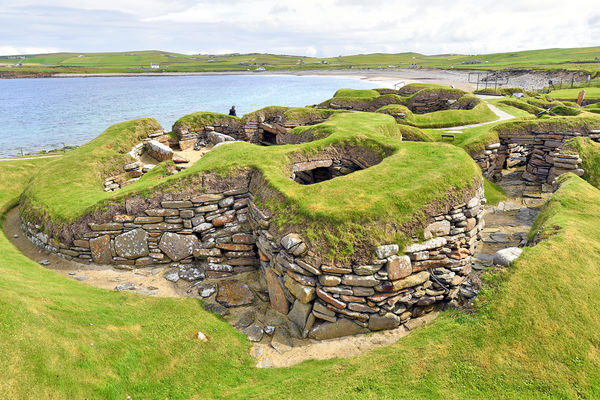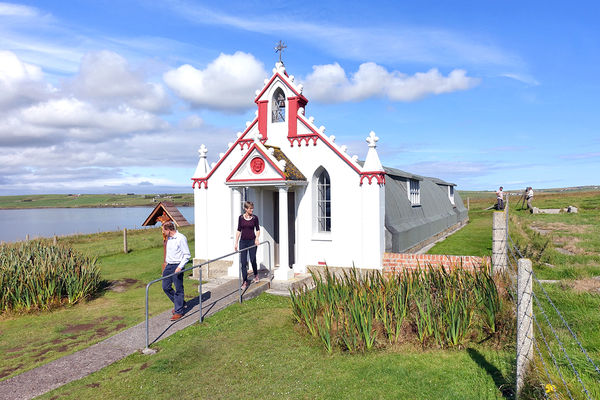The Remote Rewards of Scotland’s Orkney Islands
By Rick Steves

On a recent trip to Great Britain, I decided at the last minute to snip two days off from my time in London and go somewhere I've never been before: the Orkney Islands. Perched just an hour's ferry ride north of the Scottish mainland, these islands are remote, historic, and — for the right traveler — well worth the effort.
Orkney has two draws unmatched elsewhere in Scotland: some of the finest prehistoric sites in northern Europe, and a harbor with fascinating remnants of both World Wars.
I flew into a tiny slingshot of an airport in the only sizable town, Kirkwall. My first evening, I wandered down to the town's cathedral and happened upon a stirring band of pipers and drummers. I watched as little local kids splashed in a cultural puddle created by the band, the wail of the pipes, the towering stony church, and adoring townsfolk...and I could almost see them absorbing into their DNA what it means to be "Orcadian" (as locals are called).
With no real tradition for clans or tartans, Orkney feels not "Highlander" or even "Scottish," but uniquely Orcadian. Though Orkney was inhabited by Picts from the sixth century BC, during most of its formative history — from 875 until 1468 — it was a prized trading hub of the Norwegian realm, giving it a feel more Scandinavian than Celtic.
The next day I traveled to the west coast, where I explored the Neolithic village of Skara Brae — and as the wind blew across the bluff, I understood why those early locals lived like moles in underground stone settlements. Orkney is blanketed with the remains of Neolithic communities where subterranean homes were connected by tunnels and lit only by whale-oil lamps. Standing there on that desolate bluff, all alone with these ruins, I marveled at how all of this was accomplished without the use of metal tools.
Because sandstone is a natural insulator, these spaces — while cramped and dank — would have been warm and cozy during battering storms. A primitive sewer system, flushed by a rerouted stream, ran beneath the homes, functioning not too differently from modern sewers. The Neolithic people even created an ingenious system of giant stone slabs on pivots, allowing them to be opened and closed like modern doors.
A short drive away is Maeshowe — the finest chambered tomb north of the Alps, built around 3500 BC. From the outside, it looks like yet another big mound. But inside, the burial chamber is remarkably intact. Crouching down to squeeze through the entry passage, I kept thinking about how, for 5,000 years, people have lowered their heads to enter this sacred space. At the winter solstice, the setting sun shines through the entry tunnel, illuminating the entrance to the main cell. How prehistoric people managed to build this still puzzles present-day engineers.
Orkney's arc of scattered islands forms one of the world's largest natural harbors, called Scapa Flow, which was used by Britain's Royal Navy during wartime. During World War I, dozens of old ships and fishing vessels were intentionally sunk to block the gaps between the islets that define Scapa Flow. You can still see many of these "block ships" breaking the surface today.
At the end of World War I, a fleet of 74 captured German ships was anchored here. Barely over a century ago — just before the Treaty of Versailles was formally enacted — the British admiral took most of his ships out on a "victory lap" patrol. Once they were gone, the German commander ordered his men to scuttle the entire fleet, rather than turn it over. The interned ships had not actually surrendered, so there were no British soldiers on board. When the British returned, 52 German ships littered the bottom of the bay. While most of the ships were later salvaged for scrap, to this day, German crockery washes up on Orkney beaches after a storm.
Perched on a little rise above this harbor is Orkney's most fascinating WWII site: the Italian Chapel. Italian POWs imprisoned here were allowed to create a Catholic chapel to remind them of their homeland. While the front view is a pretty Neo-Baroque facade, if you circle around you'll see that the core of the structure is two prefab huts (similar to Quonset huts). Inside, you can see the remarkable craftsmanship of the artists who decorated the church.
Even on a short visit, Orkney can be alluring for travelers seeking a contrast to the rest of Scotland. The islands' claims to fame — astonishing prehistoric sites, Old Norse heritage, and recent history as a WWI and WWII naval base — combine to spur travelers' imaginations. When all else is equal, it's always fun to try something entirely new. I've been exploring Europe all my life…and as my visit here proves, it offers endless amazing places to uncover.

